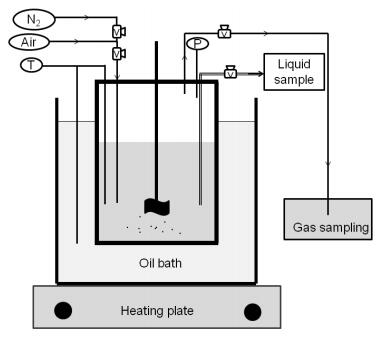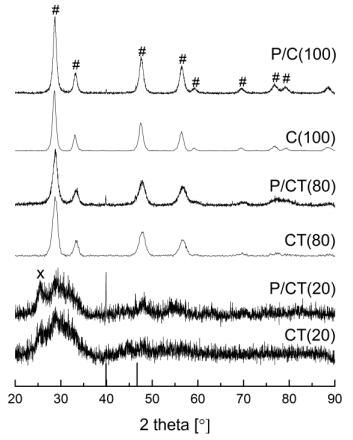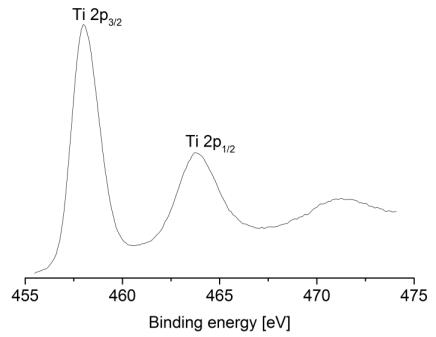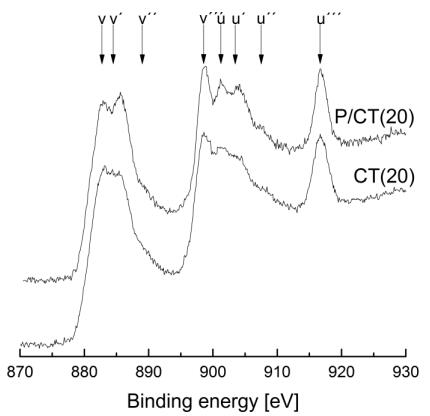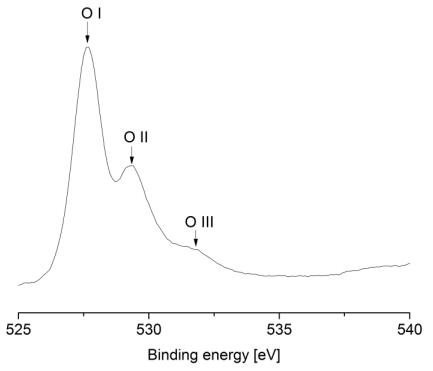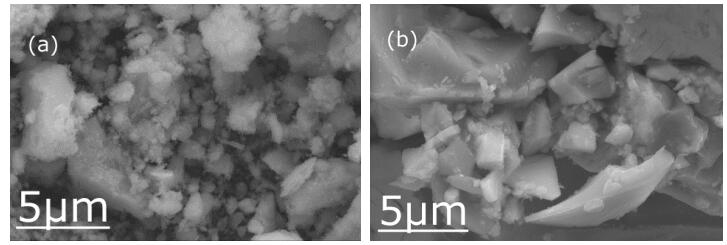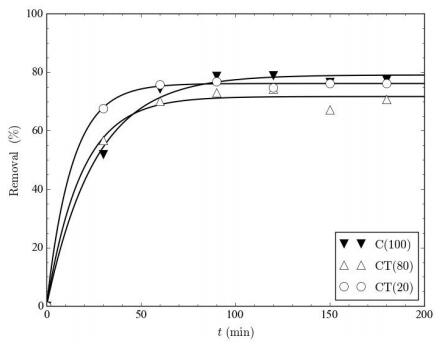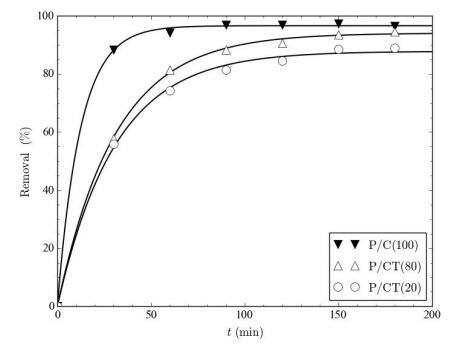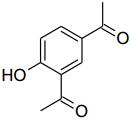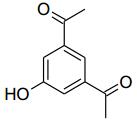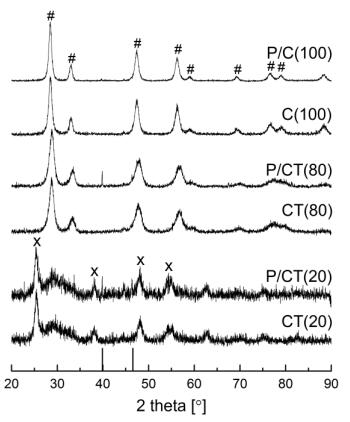Catalytic wet air oxidation (CWAO) of an aqueous solution of bisphenol A (BPA) was investigated at 160 ℃ and 2.0 MPa of air in a batch reactor. Activity of supported platinum catalysts (2.5 wt%), prepared by wet impregnation, was compared with pure cerium and cerium–titanium oxide catalysts. Supported platinum catalysts showed higher activities in the removal of BPA than pure CeO2, Ce0.8Ti0.2O2 and Ce0.2Ti0.8O2. The oxidation reaction was followed the pseudo-first order rate law and the highest BPA removal, 97% and 95%, was achieved with Pt/CeO2 and Pt/Ce0.8Ti0.2O2 catalysts respectively. The CWAO of BPA aqueous solution was not a surface area specific reaction but the more important factor affecting the activity of studied catalysts was the amount of chemisorbed oxygen of these samples.
1.
Introduction
Bisphenol A (BPA), 2, 2-(4, 4-dihydroxydiphenyl) propane, is used as an intermediate in the production of polycarbonate and epoxy resins. Final products include adhesives, protective coatings, powder paints, building materials and many other everyday items [1]. BPA is classified as an endocrine disrupting chemical (EDC) which has been reported to affect sexual development and is associated with abnormal feminizing responses in animals and possibly in humans [2,3,4]. BPA can enter the environment via manufacturing and processing but also from used plastic materials which have been disposed in landfill [1,5]. Usually the amount of BPA in surface water is rather low and typically the concentration range is from 30 ng·L−1 to 50 μg·L−1 [6,7]. Significantly higher BPA concentrations have been observed in ground water situated near landfills. Research performed near a landfill site in Osaka (Japan) showed that a BPA content of 740 μg·L−1
[8], and 3.6 mg·L−1 BPA was detected in the analysis of raw landfill leachate taken from West Germany [9]. On the contrary, considerably high BPA concentrations have been found in industrial sewages. In a study on BPA contamination in Canada, the mean concentration of BPA in raw sewage sludge was 37 mg·kg−1 [10].
According to several studies related to the toxicity of BPA to animals and humans, the need for an effective treatment method for the destruction of BPA in contaminated waters is essential. Conventional biological methods are widely used in the treatment of organic pollutants in wastewater, however, biological methods based on the activated sludge technique require quite long residence time and large-scale treatment plants. In addition, biological methods are not capable to treat phenolic compounds such as BPA from wastewaters [11,12] while the adsorption of BPA onto activated sludge can cause further problems in sludge management [13,14].
Recently, several oxidation techniques such as photocatalysis, ozonation, catalytic wet peroxide oxidation and catalytic wet air oxidation have been used for the degradation of BPA from aqueous solutions [15,16,17,18]. One of the most interesting of these techniques, catalytic wet air oxidation (CWAO), is capable of mineralizing organic compounds of wastewater at elevated temperatures (130–200 ℃) and pressures (0.5–5.0 MPa) in the presence of a catalyst to intermediates, CO2 and water [19]. Numerous homogeneous and heterogeneous catalysts have been tested in the CWAO technique. Homogeneous transition metal catalysts such as copper (Ciba-Geigy) and iron (LOPROX) salts are used in commercialized processes by Granit and Bayer respectively [20]. However, the homogeneous process always needs the additional separation step to recycle the catalyst which makes the heterogeneous catalysts using wet air oxidation technique more interesting and cost-efficient. A wide variety of heterogeneous catalysts have been studied in CWAO. Transition metals such as Cu, Ni, Fe, Mn, Co, Ce, Ti, Zr and related mixed oxides have been successfully used in CWAO of several model compounds (e.g., phenol, acetic acid) and also for industrial wastewaters originating, for example, from olive oil and the pulp & paper industry [21,22,23,24,25,26,27,28]. However, leaching of these metal oxides have been detected in oxidized effluents. Noble metals (Pt, Ru, Pd) supported on CeO2, ZrO2 and TiO2 have been found to be the most efficient catalysts in the treatment of organic effluents with CWAO [29]. Especially Ru and Pt supported on Ce–Zr or Ce–Ti mixed oxides have been observed to be more effective than noble metals on pure oxides in the abatement of organic compounds from aqueous solutions [22,30,31].
The novelty of this research is the use of platinum catalysts supported on cerium oxide and cerium–titanium mixed oxides in the catalytic wet air oxidation of an aqueous solution of bisphenol A. Oxides were prepared via the sol–gel method and platinum was impregnated onto supports by the wet impregnation technique. Characterizations of the catalysts were performed by using BET, XRD, FESEM, XPS and elemental analysis techniques. Water samples were analysed by HPLC, TOC and UPLC analytical techniques, in order to study the efficiencies of the used catalysts for the removal of BPA from water. Metal contents of the catalysts as well as the possible leaching of the catalysts materials were analysed by using the ICP-OES technique.
2.
Materials and methods
This section presents the preparation and testing procedures of the catalysts. Moreover, the analysing techniques of the water samples and characterization methods of catalysts are described in this chapter.
2.1. Catalytic materials
CeO2, Ce0.8Ti0.2O2 and Ce0.2Ti0.8O2 oxides were prepared by the sol–gel method as described in detail in Ref. [32], using Ce(NO3)3·6H2O (Alfa Aesar 99.5%) and Ti(OC4H9)4 (Fluka ≥ 97%) as precursor salts. After overnight maturing, excess ethanol and water was evaporated first in a sand bath at 100 ℃ for 5 h and then in a ventilated oven at 120 ℃ for 20 h. The grinded supports were then calcined under static air at 500 ℃ for 2 h.
Platinum catalysts (2.5 wt%) were prepared by wet impregnation followed by dry evaporation of the support in a rotating evaporator using an aqueous solution of Pt(NO3)2(NH3)4 (Alfa Aesar 99.99%) (10 g Pt L−1) as a metallic precursor salt and 8 mL of distilled water per gram of support. The catalysts were dried overnight at 120 ℃, calcined at 500 ℃ for 2 h and finally activated by a reduction under H2 gas (70 mL·min−1) for 3 h at 350 ℃ to obtain Pt in the metallic state. The abbreviations of the supports and catalysts are given in Table 1.
2.2. Catalytic oxidation experiments
Catalytic wet air oxidation was carried out in a 0.3 L stainless steel batch reactor equipped with a magnetically driven stirrer for 3 h (Figure 1). In the beginning of the reaction, 160 mL of aqueous solution of bisphenol A (Sigma Aldrich ≤ 99%) with a concentration of 60 mg·L−1, pH adjusted to 9 and 2 g·L−1 of catalyst were introduced to the reactor. The reactor was purged with nitrogen, heated to the reaction temperature (160 ℃) and then activated with air at a pressure of 2.0 MPa. Oxidation experiments with all prepared catalysts were performed at least three times.
According to the stoichiometry of oxidation reaction (Eq 1) BPA requires 18 mol O2/mol of BPA to complete oxidation. However, the solubility of oxygen in water at 160 ℃ is rather low [33] and hence BPA always remains in excess with respect to oxygen during the oxidation reaction.
During the reaction, the pressure was kept constant and at regular intervals, water samples were taken from the reactor.
2.3. Analytical methods
The concentrations of BPA were analyzed by HPLC using Shimadzu SCL 10A at a wavelength of 226 nm. Waters SunFire C 18, 5 µm particle column (2.1 mm × 100 mm) at 40 ℃ was used for the separation with 45% acetonitrile and 0.1% formic acid solution. The flow rate was set to 0.5 mL·min−1 after which a 20 µL or 30 µL (BPA concentration < 10 mg·L−1) sample was injected. The organic concentration of the water samples was measured by TOC (total organic carbon) according to the procedure described in Ref. [17]. Water samples were filtered by a 0.45 µm cellulose nitrate filter before BPA and TOC measurements in order to remove catalysts particles and suspended solids from the samples. Intermediate products of BPA oxidation were identified using a Waters Synapt G2 High Definition mass spectrometer (MS) with Waters Acquity Ultra Performance Liquid Chromatograph system (UPLC). For pre-treatment, terminal samples (20 mL) were extracted to dichloromethane (8 mL) to concentrate the sample. Acquity UPLCr BEH C18 1.7 µm particle column (2.1 × 100 mm) was used for the separation. Solvent A and B were 0.01% NH3 and acetonitrile respectively. The initial concentration of solvent B was 5% and was increased linearly during 7 minutes of run to 100%. The flow rate was set at 0.35 mL·min−1 and 5 µL sample was injected. Possible leaching of the catalyst metals (Pt, Ce, Ti) in water samples and metal content of the fresh and used catalysts were analysed using a Perkin Elmer optical emission spectrometer Optima 5300 DV ICP-OES instrument.
2.4. Characterization of catalysts
The specific surface areas of the fresh and used catalysts were determined by nitrogen adsorption–desorption isotherms at −196 ℃ with a Micromeritics ASAP 2020 analyser. The specific surface area of the samples was calculated by applying the BET theory to nitrogen adsorption data within the 0.03–0.31 p/p0 range. BJH method was used to calculate the pore volumes and pore sizes of the catalysts.
Diffractograms of the catalysts were determined by X-ray powder diffraction (XRD) experiments performed on a PANalytical X'Pert Pro X-ray diffraction system using Cu Kα1 radiation (λ = 0.15406 nm). Data was collected in the 2θ range between 20° and 90° at 0.017° intervals with 1.22 s count accumulation per step. Diffractograms were identified by comparison with the PDF database from the International Centre for Diffraction Data (ICDD) [34]. The average crystallite sizes (D) were calculated using the Scherrer equation (Eq 2).
In Eq 2, K is the shape factor (0.9), λKα is the wavelength of Cu Kα1 radiation (0.15406 nm), βc is the full width high medium (rad) and θ is the Bragg angle for the considered peak (rad).
The morphology of fresh and used catalysts were investigated by field emission scanning electron microscopy (FESEM) equipped with an energy-dispersive X-ray spectroscopy (EDS) using a Zeiss ULTRA plus microscope. X-ray photoelectron spectroscopy (XPS) analyses were performed on the ESCALAB 250Xi spectrometer (Thermo Fisher Scientific) using monochromatic Al Kα radiation source (1486.7 eV) operated at 20 mA and 15 kV. Due to the charging of the catalysts samples during XPS experiment, Ce 3d u''' peak at 916.7 eV was used for the charge correction of the XPS spectra. The Ce 3d u''' peak has been generally used to compensate for sample charging in the ceria XPS studies [35,36]. CasaXPS processing software was used for the spectral analysis. The carbon content of the fresh and used catalysts was determined by Thermo Scientific FlashTM 2000 organic elemental analyser (OEA) in order to investigate the amount of possible carbonaceous deposits on the surface of catalysts.
3.
Results and discussion
This section summarizes the characterization results (both fresh and used supports and Pt catalysts) and the outcomes from oxidation experiments.
3.1. Specific surface area and X-ray diffraction
Table 2 summarizes the average crystallite size, BET surface area and average pore width of the fresh catalysts. The average crystallite size of C(100) is about 9.2 nm. The adding of smaller amounts of Ti to C(100) decreases the average crystallite size to 8.1 nm (CT(80)) due to the smaller ionic radius of Ti4+ (0.68 Å) compared to Ce4+ (0.97 Å) [26]. However, there is no change in the specific surface area.
X-ray diffractogram of C(100) sample (Figure 2) calcinated at 500 ℃ shows the presence of cerium oxide as indicated by the diffraction peaks (marked with #) at about 2θ = 28.5°, 33.1°, 47.5°, 56.3°, 59.1°, 69.4°, 76.7° and 79.1° corresponding to the planes of the typical face-centered cubic structure of CeO2 (JCPDS: 01-081-0792) [34].
When adding small amounts of titanium to CeO2, the fluorine-type structure is preserved and no relevant Ti peaks is observed by XRD on CT(80) suggesting the incorporation of Ti ions in the cubic lattice to form an homogeneous Ce–Ti–O solid solution. In the X-ray diffractogram of CT(20) (Figure 2) a weak peak at diffraction angle of 25.5° could be attributed to anatase titania (JCPDS: 01-089-4921) [34] whilst CeO2 particles tend not integrate the crystalline phase and CeO2 appears as an amorphous. This could be due to the insertion of Ti ions into the CeO2 lattice and replacement of Ce ions. As a coincidence, the long range order structure of the CeO2 crystal is destroyed which restrains the increasing of the CeO2 particles [25,26]. Although the crystallite size of CT(20) is not detected due to the asymmetric diffraction peaks, according to the large surface area of support the crystallite size of CT(20) has decreased (Table 2). In the amorphous structure large lattice distortion is predominated which also explains the large surface area of the CT(20) support [37]. The smaller surface area of CT(80) might be due to a partial destruction of the ordering of TiO2 or a blockage of the pore entrance [38]. Increasing Ce content may also lead to the segregation of CeO2
[39]. Moreover, X-ray diffractograms of the platinum catalysts (Figure 2) showed two peaks of platinum at diffraction angles of 39.9° and 46.3° (marked with —) which are characteristic to metallic platinum (JCPDS: 00-004-0802) [34,40,41]. Both diffraction peaks of platinum are clearly seen in the diffractograms of P/CT(80) and especially in P/CT(20) but in P/C(100) only the highest peak at 2θ 39.9° can be observed. This refers to the strong interaction of the active metal and support. Furthermore, no change in the X-ray diffractograms of P/C(100) and P/CT(80) (Figure 2) can be observed due to the introduction of 2.5 wt% platinum whilst in the X-ray diffractogram of P/CT(20) the peak at 2θ 25.5° attributed to anatase titania is stronger than in CT(20). This could be due to the thermal treatments, i.e., calcination and following reduction of Pt catalysts.
3.2. XPS analysis
An example of Ti 2p spectrum can be seen in Figure 3 while Table 3 describes the Ti 2p binding energies of all Ti containing catalysts. The binding energies of Ti 2p3/2 at about 457 eV and Ti 2p1/2 at about 463 eV (Table 3) correspond to TiO2 in Ce–Ti supports and Pt catalysts [26,39].
The Ce 3d XPS spectra of CT(20) and P/CT(20) are seen in Figure 4. The complicated spectra can be resolved into eight components marked with v and u which corresponds to spin-orbit coupling of 3d5/2 and 3d3/2 states respectively. The peaks denoted by v and v'' could be attributed to the mixing of 3d94f2(O2p4) and 3d94f1(O2p5) Ce4+ final states and v''' to the 3d94f0(O2p6) Ce4+ final state. In addition, the peak marked with v' is associated to the 3d94f2(O2p6) Ce3+ final state. The series of 3d3/2 level peaks denoted by u can be explained in the same way [42,43].
Considering Table 3, the binding energies of v peaks for the pure supports and Pt catalysts are in good agreement with existing reported data [44,45]. The ratio of intensity of u''' peak to the total Ce 3d intensity depends on the Ce4+/Ce3+ ratio, and hence the relative amount of Ce4+ present on the surface of the catalyst is the area under u''' relative to the total area under the Ce 3d spectrum [42]. As shown in Table 3, for CeO2 and Ce richer samples the u''' is around 13–14% while with Ti richer samples the relative amount of Ce4+ has decreased to around 9%. Moreover, u' and v' peaks are clearly present in the Ce 3d spectra of CT(20) and P/CT(20) in Figure 4 indicating that the addition of larger amounts of titanium to the CeO2 lattice increases the amount of Ce3+ on the surface of these catalysts [26]. However, a certain amount of Ce3+ has probably formed during XPS analysis due to the photoreduction of Ce4+ ions which was demonstrated in the study of Larsson and Andersson [46]. For Ce–Ti catalysts increasing the analysis time, the decrease in the area ratio between u''' peak to the total Ce 3d region was observed while at the same time, u' and v' peaks were increased. This phenomenon shows the reduction of Ce4+ to Ce3+ during XPS analysis. Furthermore, amorphous Ce–Ti mixed oxides prepared by the sol–gel method have been found to be more easily reduced due to photoreduction than the crystalline form and physical mixture of these oxides [36,39,45].
An example of the O 1s spectrum (C(100)) can be seen in Figure 5. The spectrum is composed of three peaks referred as lattice oxygen (O Ⅰ), chemisorbed oxygen (O Ⅱ) and oxygen of CO32− groups (O Ⅲ) [26,47,48]. The O 1s peaks at about 527.6–529.4 eV (Table 4) could be attributed to the lattice oxygen while the smaller O 1s peaks around 528.7–530.2 eV belong to the chemisorbed oxygen for C(100), CT(80), CT(20), P/C(100), P/CT(80) and P/CT(20) catalysts [26,45]. O Ⅲ is present only in the C(100), P/CT(80) and P/CT(20) samples.
As shown in Table 4, the amount of lattice oxygen is larger than the amount of chemisorbed oxygen in all samples. In CT(80) and P/CT(80) containing smaller amounts of titanium the chemisorbed oxygen content is bigger than in CT(20) and P/CT(20) with higher amounts of titanium. This is not in agreement with the Ce3+ content of catalysts (Table 3). Typically, reduced Ce can form vacancies and unsaturated chemical bonds that create a charge imbalance on the surface of these catalysts, which make the existence of the chemisorbed oxygen possible on the catalyst surface. However, Ti4+ with a smaller ionic radius than Ce can enter the CeO2 lattice and substitute for Ce3+. This might affect the charge balance of the surface and lead to the decrease in the amount of chemisorbed oxygen on the catalyst surface which probably explains the smaller amounts of O Ⅱ specie in the Ti rich catalysts. However, the addition of platinum increased the amount of chemisorbed oxygen in all catalysts. Therefore, platinum can activate the oxygen species' migration on the support and further improve the activity of these catalysts [22,49]. Chemisorbed oxygen has a very important role in the oxidation reaction and so different amounts can affect the activity of Ce and Ce–Ti catalysts [26].
The XPS binding energy values of Pt 4f spectra (not shown) of reduced platinum catalysts are given in Table 5. All platinum catalysts show several peaks in the Pt 4f region due to the multiple oxidation state of the samples. The Pt 4f7/2, 5/2 peaks at 70.8–71.1 eV and 73.4–76.6 eV could be attributed to metallic Pt as well as Pt 4f7/2, 5/2 peaks at 71.4–72.4 eV, 75.3–76.2 eV and 74.1–74.6 eV, 76.3–77.2 eV could be assigned to Pt2+ and Pt4+ respectively [50]. Considering the binding energy values of Pt catalysts in Pt 4f spectra, the samples containing more ceria has slightly higher binding energy than the P/CT(20) catalyst (Table 5). This shifting of the binding energy values could be due to the interaction of the platinum with ceria and further electronic polarization of the platinum precursor clusters [50]. Moreover, the shifting of the binding energies has been found to be strongly dependent on the cerium content of the Pt catalysts [51]. Therefore, P/C(100) and P/CT(80) catalysts with high Ce content show higher Pt 4f7/2 binding energy than P/CT(20). Despite the reduction of the Pt catalysts, platinum is found to be dispersed mostly in 2+ and 4+ (>80%) oxidation states in all samples. Therefore, the strong interaction between active metal and support prevented platinum to reduce in the metallic state [50] in the used reaction conditions.
3.3. ICP-OES and FESEM-EDS analysis
FESEM-EDS was used for the analysing the morphology and composition of catalysts' surface. In the FESEM image of P/C(100) (Figure 6a) typical porous structure of ceria [52] with a wide particle size can be observed whilst in P/CT(20) catalyst particles were characterized by an angular shape (Figure 6b).
Table 6 summarizes the wt% of the catalyst metals determined by ICP-OES and FESEM-EDS. Ce and Ti content of the supports are in good agreement in the target values of these metals in the catalysts. After impregnation of the active metal to the supports, no effect to the wt% of Ce and Ti can be noticed. Moreover, Ce and Ti seem to be well dispersed on the surface as well as in the bulk of the catalysts since both analysing techniques give quite similar results. Analysing the platinum content of the catalysts by ICP-OES, the wt% of the active metal is quite near the target value (2.5 wt%). However, according to FESEM-EDS analysis, the dispersion of Pt is not homogeneous, except in P/CT(20). This might be due to a larger particle size of the Ti richer Pt catalyst (Figure 6b) compared to the smaller particle size of P/C(100) (Figure 6a).
3.4. Catalytic wet air oxidation of bisphenol A
The thermal stability of the bisphenol A aqueous solution (60 mg·L−1) at operating conditions (160 ℃, 2.0 MPa of air) was first evaluated. No removal of BPA and TOC was observed (not shown) after 3 h of experiment. Catalytic wet air oxidation experiments were carried out with both pure supports and with active metal. All catalysts were active in the abatement of BPA (Table 7). The oxidation reaction was very fast: After 30 minutes reaction the lowest abatement of BPA was already 50% (C(100)) and the highest almost 90% (P/C(100)) (Figures 7 and 8). No significant differences between used supports in the BPA removal were observed and after 3 h experiment, the BPA abatement was around 75%. By adding active metal to the supports, the highest BPA removal (97%) was achieved with the P/C(100) catalyst. The activity order of the catalysts was P/C(100) > P/CT(80) > P/CT(20) > C(100) > CT(20) > CT(80). Surprisingly, the activity order of the catalysts was not in agreement to the BET surface areas of the samples (Table 2). The lower activity of the Ti richer catalysts with higher BET surface area could be due to the lower amount of chemisorbed oxygen of these catalysts (Table 4). In fact, the order of the activity was almost the same as that of the surface concentration of chemisorbed oxygen for Pt catalysts.
In the TOC conversions of the oxidation reactions (Table 7), no significant differences between the used catalysts in the organic concentration removal were observed. The TOC abatement was slightly higher with Pt catalysts than with pure supports.
The lower removal of TOC than BPA was assumed to be due to the forming of by-products in the BPA oxidation reaction. Therefore, a qualitative analysis was performed by UPLC-MS to the oxidized water samples. According to the obtained mass spectra (not shown), five different by-products in addition of BPA were identified from the terminal water samples from which compounds B and C existed in two isomers (Table 8). The products A, i.e., 4-(prop-1-en-2-yl)phenol and B1 (1-(4-hydroxyphenyl)ethan-1-one, i.e., p-hydroxyacetophenone) were detected also as degradation products in the photocatalytic treatment of BPA [53]. Moreover, p-hydroxyacetophenone was identified as a main by-product in the CWAO of BPA by titanate nanotube-based catalysts in addition of acetic and formic acids [54] which were not detected in the UPLC-MS analysis. However, with the low BPA concentration and therefore, the low concentration of intermediates, major amount of intermediates could be absorbed on the catalyst's surface and not observed in the liquid phase. Although carboxylic acids were not detected in the UPLC analysis, the pH values of pure supports catalysed oxidized water samples were near five which refers the forming of formic and acetic acids. Typically, these short chain carboxylic acids are refractory for total oxidation to CO2 and water with metal oxide catalysts [26]. Further, compound C with the molecular weight of 178 g·mol−1 existed in two isomers 1, 1'-(4-hydroxy-1, 3-phenylene)di(ethan-1-one) (product C1) and 1, 1'-(5-hydroxy-1, 3-phenylene)di(ethan-1-one) (product C2) was not detected in the earlier studies related to the oxidation of BPA.
3.5. Kinetic modelling of oxidation reaction
The kinetics of BPA removal was modelled according to the pseudo-first order rate-law. The measured data was fitted by using a standard non-linear least squares algorithm, Eq 3,
in which total removal (RTot) and rate constant (k) were used as fitting parameters. The term "t" was the oxidation time. The calculated R2 values and residual analysis were used as evaluating parameters for the goodness of the fit. Figure 7 shows both the experimental (symbols) and fitted (lines) BPA removals as a function of reaction time for pure supports. The possible rate constants for C(100), CT(80) and CT(20) catalysts were 0.0387, 0.0541 and 0.0740 min−1, respectively. Therefore, the addition of more titania to the support increased the reaction rate in the CWAO of BPA and the kinetic constant of CT(20) was almost 2 times higher as that of C(100). The fitted and observed abatements of BPA for Pt catalysts are presented in Figure 8 and the calculated rate constants were 0.0810 (P/C(100)), 0.0322 (P/CT(80)) and 0.0324 min−1 (P/CT(20)). On the contrary to the supports, the addition of active metal improved the reaction rate of the CWAO of BPA only with P/C(100) and the kinetic constant of P/C(100) was 2.5 times higher than that with P/CT(80) and P/CT(20).
3.6. Characterization of used catalysts
After oxidation reaction of BPA, the diffraction peaks characteristics to cerium oxide have shown no changes in both used supports and Pt catalysts (Figure 9). Furthermore, the platinum peak at 2θ 39.9° is obvious in all used Pt catalysts. However, in the diffractograms of used CT(20) and P/CT(20) four clear peaks at a 2θ values at approx. 25°, 38°, 48° and 54° can be seen while only weak peak at diffraction angle 25° is obvious in fresh samples (Figure 2). The diffraction peaks (marked with x) at 25.5°, 38.1°, 48.0° and 54.4° for CT(20) and P/CT(20) respectively, can be attributed to anatase titania (JCPDS: 01-089-4921) [34]. No rutile titania peaks are detected and so the TiO2 phase exists as an anatase structure in the used samples.
The crystallite sizes of used C(100), CT(80), P/C(100) and P/CT(80) catalysts are in the same range (8.2–9.2 nm) to the fresh samples (Table 2). The structure of the used CT(20) and P/CT(20) is still amorphous and the faint scattering of the diffractograms (Figure 9) prevents the exact determination of the crystallite size of these catalysts. Moreover, the surface area of the used Ce and low amount of Ti containing samples stayed quite steady and the lowest decrease occurred in C(100) (6.1%) and P/CT(80) (7.2%) samples. However, after oxidation reaction the surface area of CT(20) and P/CT(20) decreased 55 and 36%, respectively. Therefore, the amount of accumulated carbon on the surface of the catalysts was examined by elemental analysis for both fresh and used catalysts (Table 9).
According to the results, low amount of carbon had accumulated on the surface of fresh catalysts even before the oxidation reaction of BPA. However, this was probably due to the absorbed CO2 on these samples. Moreover, the addition of Ti to the supports slightly prevented the adsorption of carbonaceous molecules on the fresh catalysts. After oxidation reaction, rather low carbon contents were observed on the surface of the used catalysts. In fact, in part of the catalysts the initial carbonaceous deposits had actually removed during CWAO of BPA. Additionally, the accumulation of carbon during CWAO of BPA was more intensive in pure supports than samples with active metal. However, it is obvious according to elemental analysis that carbonaceous deposits were not responsible for the loss of specific surface area of CT(20) and P/CT(20). Therefore, the phase changes observed in X-ray diffractograms after oxidation reaction caused the decrease in the surface area of these samples. Further, P/C(100) and P/CT(80) which were the most active catalysts in the CWAO of BPA, in addition of oxidising the organic compounds from treated effluent, removed also the initial carbonaceous deposits from catalysts surface.
Additionally, according to the metal content analysis of used catalysts by ICP-OES the amount of Ce, Ti and Pt stayed quite steady and no leaching of these metals occurred in terminal water samples after oxidation reaction.
Consequently, according to the post characterization of the catalysts, phase composition of Ce and small amount of Ti containing samples stayed steady and no large changes in the surface area of these samples occurred after CWAO of BPA. However, in spent CT(20) and P/CT(20) anatase titania peaks appeared in XRD analysis and 55 and 36% decrease in the surface areas was observed. Therefore, P/CT(80) was the most stable catalysts in the CWAO of BPA due to the negligible loss of surface area and unchangeable phase structure. Moreover, no accumulation of carbonaceous deposits on the surface of the P/CT(80) were observed after oxidation reaction.
4.
Conclusions
Platinum supported on sol–gel prepared CeO2, Ce0.8Ti0.2O2 and Ce0.2Ti0.8O2 were used as catalysts in the catalytic wet air oxidation of an aqueous solution of bisphenol A. The addition of Ti to CeO2 affects the surface properties of the mixed oxides. In CT(20) the higher Ti content turns CeO2 into an amorphous and increases the specific surface area of the sample. However, CWAO of BPA is not a surface area specific reaction. The oxidation reaction was followed the pseudo-first order rate law and the highest abatement of BPA was achieved with P/C(100) and P/CT(80) catalysts, 97 and 95% respectively. The excellent activity of these catalysts is to do with the high concentration of chemisorbed oxygen and Ce4+ on the surface of the catalysts. Moreover, no phase changes and carbonaceous deposits existed in P/CT(80) and P/C(100) samples after oxidation reaction. Consequently, these catalysts show high potential in the removal of endocrine disrupting chemicals from wastewaters by catalytic wet air oxidation.
Acknowledgements
The authors gratefully acknowledge the Academy of Finland for providing research funding, AOPI project (263397) within the research program for Sustainable Governance of Aquatic Resources (AKVA). Centre of Microscopy and Nanotechnology at the University of Oulu is also acknowledged for its research facilities in XPS analysis.
Conflict of interest
The authors declare that they have no conflicts of interest.









 DownLoad:
DownLoad:
